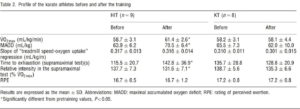
High-Intensity Interval Training (HIIT) has a considerable contribution in developing karate-specific abilities. It has been shown that karate performance relies on both anaerobic and aerobic energy systems (which one contributes more is still questionable), and the body’s ability to use oxygen and its capacity to sustain high-quality work in the presence of lactates and hydrogen ions.
People continuously look and try various training modalities to give them the “biggest band for their buck.” This means finding a workout that will provide profound physiological changes and adaptation with less work. For this reason, many athletes include high-intensity interval training (HIIT) in their training programs as a primary or complementary tool.
If planned well and implemented correctly, HIIT training modalities can successfully be incorporated as part of the regular training sessions. For example, a study where high-level karate practitioners, members of the French karate national team, were exposed to HIIT as a complementary tool to their karate training showed significant improvement in aerobic and anaerobic energy systems.
The training method used in the study is very similar to well known Tabata Protocol, which comprises 20 seconds of work, followed by 10-sec rest, done in 8 cycles, for a total of 4 minutes.
At first glance, the 4-min workout seems too short, and you might think this is a waste of time considering that you spend 10 min to warm up and 10 min to cool down. However, there is a good reason why it lasts only 4 minutes. In the study performed by Izumi Tabata, the work done by the athletes was at 170% of your VO2max. To put it in perspective, you feel a burning sensation in your chest, your face is red, and smoke is coming out of the ears.
We have to be honest that it is improbable that anyone would sustain work at such a high intensity outside of the laboratory during regular training. Therefore we can say that the intensity should be as high as you can handle. But, again, “real” suffering is required.
Some people say they’ve done 4-5 Tabata sets in one workout. What they want to say they have used the Tabata Protocol for their biceps curl and triceps extension, which are exercises that cannot initiate any significant changes in your anaerobic and aerobic capacity. However, it sounds “badass” or “hardcore” when you share on social media.
Try to do eight sets of a 20-second max (“real” max, not “kind of max”) sprint, and you’ll see what I am talking about. If done with maximum intensity, the last 20 seconds is when your real character gets revealed, during which you’ll be moving like a snail, feeling your legs heavy and barely moving your feet off the ground. This is the reason why you do only one Tabata set.
The study mentioned above used modified Tabata Protocol where the karatekas performed 7-9 sets of 20 seconds treadmill run at 140% of their VO2max followed by 15-second rest. The HIIT training was done two times a week, for seven weeks, in addition to regular karate practice. At the end of the study, the group that used HIIT showed significant positive physiological changes in aerobic and anaerobic capacity compared with the one that used only karate training nine times a week.

When implementing high-intensity interval training modalities in your training routine, the Tabata Protocol is not necessarily the only one available. Below you can find more information about the three leading protocols related to interval training.


